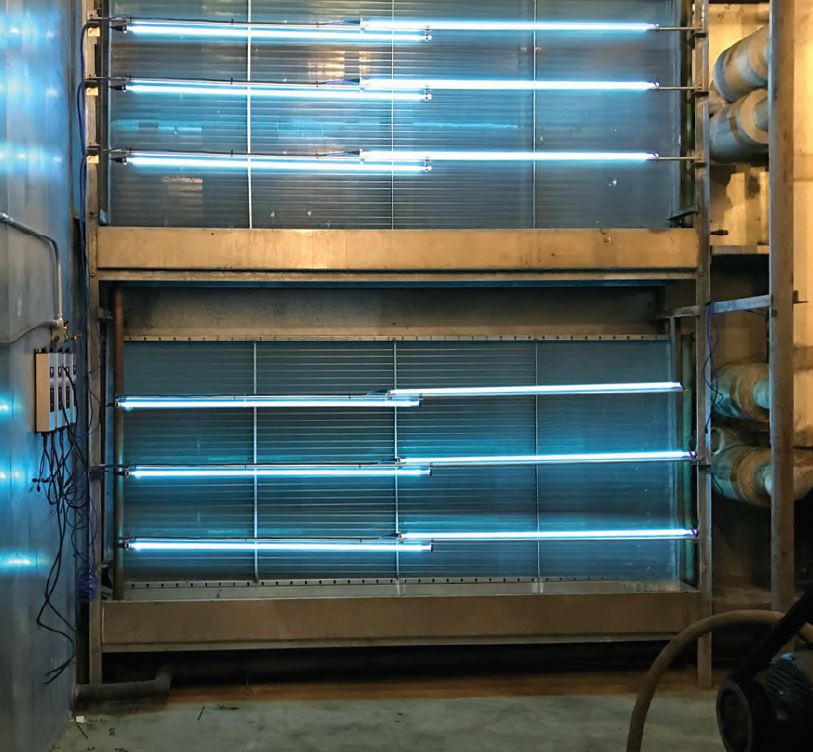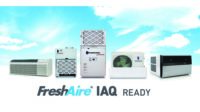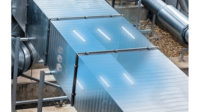Fresh-Aire UV, which makes ultraviolet light products designed to improve indoor air quality (IAQ), experienced healthy annual growth for several years through 2019.
Then, the coronavirus pandemic struck — and interest in ultraviolet light skyrocketed.
Aaron Engel, vice president for business development at the Jupiter, Florida, company, said year-over-year growth from about 2015 through 2019 was typically between 20% and 25%. In the last two years, however, business at Fresh-Aire UV and other UV equipment manufacturers shot off the charts, as UV light in the “C” spectrum, or UV-C, has been shown to be effective in battling SARS-CoV-2, the virus behind the pandemic.
“We saw a tenfold increase in business,” said Engel during a phone interview. “UV systems gained a lot of credibility at the beginning of the pandemic.”
UV-C has been used in HVACR systems for years, Engel said, but with the pandemic, "You had a whole new market.”

COIL CLEANSING: These Fresh-Aire UV disinfection lamps are mounted on a large coil system. (Courtesy of Fresh-Aire UV)
Now, companies like Fresh-Aire UV are working to keep up with increased demand while also trying to capitalize on a business climate in which awareness of using UV-C as a disinfectant has greatly increased.
“Everyone’s going to be looking for higher air quality,” said Engel.
Casting Light on UV-C
Dean Saputa, vice president of sales at UV Resources, a UV-C manufacturer in Valencia, California, said he expects the demand for commercial UV products to remain high, as the pandemic has shifted the perception of UV technology from a “want” (because it can improve HVAC efficiency by cleansing coils) to a “need” (because it’s important for health and safety).
UV-C light — UV light with wavelengths of between about 200 and 280 nanometers, or nm — has long been used as a disinfectant, and testing has shown that UV-C light with a wavelength of 254 nm is a particularly good way of inactivating the SARS-CoV-2 virus. So-called far-UV-C light — UV light at 222 nm — has also been found to be effective, according to a study from Columbia University. Far-UV-C light is thought to pose less risk to humans.
“You have to have the science and the data to support those claims, and that’s what ultraviolet has,” said Engel.
(UV lights should be installed by a trained professional and properly shielded, however, as exposure has been shown to damage the skin and eyes.)

Click drawing to enlarge
AIRSTREAM DISINFECTION: A drawing that illustrates how an in-duct UV-C light air-cleansing system works. (Courtesy of UV Resources)
Current Demand
UV-C technology is used in a wide variety of non-residential facilities, including commercial and public buildings, hospitals and other medical facilities, schools, and manufacturing and food production facilities. Saputa said the greatest demand for UV Resources’ products now is coming from offices, schools, and retail centers and other light commercial buildings.
“Mechanical engineers want to ensure that the HVAC equipment they specify continues to perform at peak capacity for as long as possible,” Saputa said. “Equipment designers ... appreciate that products have greater value when they perform at full capacity long after startup.”
The HVAC market, Saputa said, is starting to view UV-C in the same way as air filtration; that is, “Every application works better, longer, and users are happier when UV-C is installed in air handlers,” he said.
Miki Minic, senior chief engineer at Jones Lang LaSalle, an international real estate services company, said increased interest in UV-C has been coming from clients at commercial office buildings, government and public buildings, and more recently, medical facilities.
“Surprisingly, restaurants, retail, and other food production industries are lagging behind,” Minic said. That can be attributed to a lack of awareness of the benefits of UV-C or, in some cases, cost concerns, he added.
At the Air-Conditioning, Heating, and Refrigeration Institute (AHRI), a trade group that represents HVACR manufacturers, including some that make UV-C products, Francis Dietz, the vice president for public affairs, said school districts especially are showing great interest in UV-C, as federal funding for improving IAQ in schools is available.
Engel said greater interest in UV-C is coming not just from building owners and managers, but also from HVACR contractors and wholesalers.
“The awareness has broadened the marketplace,” he said.
Pre-pandemic at Fresh-Aire UV, Engel said, the “vast majority” of its UV-C light products were put into coil-cleaning systems, as keeping coils disinfected has been shown to increase their efficiency.
But since coronavirus, “Now, all of a sudden, duct-mounted systems became popular,” he said.
Saputa, at UV Resources, said he’s also noted an increase in the popularity of duct-mounted systems, as well as in upper-air (also called upper-room) applications. Research by the American Society of Heating, Refrigerating and Air-Conditioning Engineers (ASHRAE) has bolstered the reputation of both in-duct and upper-air UV-C for infection control, he said.
UV Resources’ wall-mounted upper-air UV system, Saputa said, is typically used in high-traffic commercial areas such as lobbies, health clubs, conference rooms, and break rooms.
Minic said JLL clients, either prior to leasing space or during lease tenures, are most commonly asking for UV-C in either coil systems or return-air plenums.
Vice president for business development, Fresh-Aire UV
Less Urgency
However, while awareness remains high, Engel said, there’s been a bit of a pullback in buying: That tenfold increase in business that he described at Fresh-Aire UV has tapered off to a level of about four times what it was before the pandemic.
At UV Resources, Saputa said inquiries into its UV-C products as germicidal solutions are about four times what they were before the pandemic began.
“Now that we’re on the other side of COVID, that awareness is there but the urgency is not,” said Engel. That, he added, means the company will have to work harder to turn increased awareness of the benefits of UV-C into business.
UV Resources and Fresh-Aire UV provide UV-C products both to HVACR equipment manufacturers and the retrofit market. Engel said OEMs account for only about 10% of Fresh-Aire UV’s business; Saputa said about a third of its business is with OEMs.
Ultimately, Engel and Saputa said, UV-C will become widely viewed as essential to HVACR systems, the way filters are now.
“I feel in time that UV technology will become as commonplace as filtration,” said Engel. “The market is understanding that the filter is not the be-all, end-all.”






Report Abusive Comment